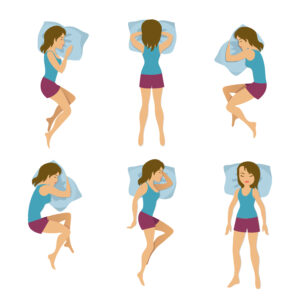Best Sleeping Position for Chiari Malformation
Navigating the challenges of Chiari Malformation can be tough. And when it comes to getting some quality shut-eye, things can get even trickier. You’re not alone in this journey, and I’m here to help shed some light on the best sleeping position for Chiari Malformation that might offer you some relief.
What is Chiari Malformation?
Chiari Malformation isn’t just a complicated name; it’s a complex condition that many people might not be familiar with. Essentially, it’s a situation where a portion of the brain, specifically the cerebellum, pushes downward, descending out of the skull and into the upper spinal canal. This unusual positioning can lead to a myriad of symptoms. Some folks experience headaches, while others might face issues related to balance and coordination. Interestingly, many of these symptoms can become more pronounced or noticeable based on one’s position, especially during sleep. And that leads us to wonder, why is that the case?
Symptoms of Chiari Malformations
- Headaches: Often severe and can be brought on by coughing, sneezing, or straining.
- Neck pain: This discomfort is frequent and can radiate down the spine.
- Dizziness and balance problems: Individuals might feel unsteady or have vertigo symptoms.
- Visual disturbances: This can include blurred vision, double vision, or sensitivity to light.
- Difficulty swallowing: Some people might choke frequently or feel like food gets “stuck.”
- Sleep apnea: This condition results in brief pauses in breathing during sleep.
- Tinnitus: A ringing or buzzing sound in the ears.
- Poor hand coordination: Tasks requiring fine motor skills might become challenging.
- Numbness and tingling: These sensations can occur in the hands or feet.
- Muscle weakness: This can manifest in various parts of the body.
- Speech problems: Some individuals might develop a hoarse voice or have difficulty articulating words.
Why Sleep Position Matters with Chiari Malformation
We all love the feeling of sinking into a comfortable bed after a long day. However, for those with Chiari Malformation, sleep position takes on a whole new level of significance. Because of the peculiar positioning of the cerebellum in these individuals, certain sleeping postures can either alleviate or exacerbate their symptoms. The way the head aligns with the spine, the tilt of the neck, and even the height of the pillow can all influence the amount of pressure exerted on the brain and spinal cord. In essence, the right sleep position can be the difference between a night of restful slumber and a night filled with discomfort.
Impact on the Brain
Let’s think about our brain for a moment – that incredibly vital organ housed within our skulls. It’s protected by a bony casing and cushioned by cerebrospinal fluid. Now, in someone with Chiari Malformation, the descending cerebellum can obstruct the normal flow of this fluid. This disruption can lead to increased pressure within the brain. Moreover, certain positions, like lying flat without adequate neck support, can further intensify this pressure, leading to heightened symptoms. It’s a bit like how water flow changes based on the kinks and bends in a hose.
Relieving Pressure and Pain
So, how does one find relief? Well, understanding and adjusting one’s sleeping position is a crucial start. By elevating the head or ensuring the neck aligns well with the spine, one can facilitate a smoother flow of cerebrospinal fluid, reducing the intracranial pressure. Additionally, using supportive tools like specially designed pillows or cervical collars can significantly aid in maintaining these beneficial positions. Think of it as fine-tuning your sleeping posture, just like how you’d adjust a chair for optimum comfort during work. Over time, these minor adjustments can translate into significant relief from pain and other symptoms.
Best Sleeping Position for Lower Back Pain: Comfort and Relief
Various Sleeping Positions Explored
Sleeping positions play a pivotal role in determining the quality of sleep, especially for individuals with specific health conditions like Chiari Malformation. Even without such conditions, your sleeping posture can impact various aspects of your health, from spinal alignment to respiratory efficiency. It’s a topic that merits deep exploration, especially given the myriad ways people choose to snooze. Let’s dive into some of the most popular sleeping positions and understand their benefits and potential drawbacks.
Supine Position (On Your Back)
Resting on your back, with your face directed upwards, is what we call the supine position. This position can be beneficial as it allows for even distribution of weight across the body, minimizing pressure points. Moreover, the spine remains in a neutral alignment, reducing the chances of backaches. For those with Chiari Malformation, elevating the head in this position might offer relief. However, a word of caution: this position might exacerbate snoring for some, as the tongue falls back, partially obstructing the airway.
Side Sleep
There’s a reason many people prefer sleeping on their side – it’s comfortable! Side sleeping, especially on the left side, can promote better heart function due to gravity’s assistance in circulation. For pregnant women, this position is often recommended to optimize blood flow to the fetus. However, one should ensure the neck and spine remain aligned in this position. A well-placed pillow between the knees can also help in maintaining hip alignment, ensuring a restful night.
Prone Position (On Your Stomach)
The prone position or sleeping on the stomach can be a bit controversial. While it can reduce snoring and instances of sleep apnea, it’s not the most spine-friendly choice. The neck twists to one side, which could lead to discomfort or long-term issues. But here’s a tip for stomach sleepers: placing a thin pillow or even a rolled-up towel under the pelvis can help maintain a more neutral spine position, making this posture a bit more ergonomic.
Bodysuit Position
Now, the bodysuit position might sound a bit avant-garde, but it’s essentially a curled-up position where one’s limbs are closely drawn towards the body, almost resembling a fetus. This posture offers a sense of security and warmth for many, and it’s not uncommon among those who prefer a cozy sleeping environment. Some believe it traces back to our earliest days of existence, providing a womb-like comfort. However, ensure you don’t curl up too tight; this might restrict deep breathing, which is essential for rejuvenative sleep.

Tips for Comfortable Sleep
- Optimal Pillow Positioning: Ensure your pillow is neither too high nor too low. It should align your neck with the spine, preventing any undue stress.
- Mattress Matters: Invest in a good quality mattress that provides support to your spine while being comfortable. A mattress that’s too firm or too soft can lead to sleep disturbances.
- Room Temperature: Keep the bedroom at a comfortable temperature, ideally between 60-67°F (15-19°C). Cooler environments often promote better sleep.
- Limit Light Exposure: Dim lights an hour before bedtime. Excessive light, especially blue light from screens, can disturb the production of the sleep hormone melatonin.
- Consistent Sleep Schedule: Go to bed and wake up at the same time daily, even on weekends. Consistency reinforces the body’s sleep-wake cycle.
- Quiet Environment: Reduce noise levels using earplugs, white noise machines, or soothing background sounds. A quieter environment often leads to deeper sleep.
- Limit Caffeine and Alcohol: Avoid beverages with caffeine or alcohol close to bedtime. They can interfere with your sleep cycle and reduce sleep quality.
- Comfortable Sleepwear: Wear loose and breathable nightwear. Avoid tight or itchy fabrics that might disrupt your sleep.
- Foot Elevation: Elevating your feet slightly can improve circulation and potentially lead to a more restful sleep.
- Relaxation Techniques: Incorporate relaxation methods like deep breathing, meditation, or reading a book to help calm your mind before hitting the bed.
By following these tips, you can optimize your sleep environment and routine, leading to more restful and rejuvenating nights.
Other Considerations
When considering a good night’s sleep, especially for those with medical conditions like Chiari Malformation, there are myriad factors to keep in mind beyond just the position. For instance, while the physical alignment and posture play a crucial role, one shouldn’t overlook the importance of mental and emotional well-being. Anxiety, stress, and overthinking can become formidable enemies of sleep. They often sneak into our bedtime routines, making it difficult to find rest even in the most comfortable of positions. Furthermore, dietary habits play a role too. Eating heavy meals right before bedtime or consuming stimulants can disrupt sleep, regardless of how you position yourself.
Sleeping Environment
The ambiance of your sleeping environment plays a pivotal role in determining the quality of your sleep. It’s essential to create a sanctuary that’s conducive to relaxation and rest. Start with the basics: Ensure your room remains dark, utilizing blackout curtains if necessary. Ambient noise, often overlooked, can be a significant disruptor. Consider using white noise machines or earplugs to combat unwelcome sounds. The quality of the air matters too. Make sure your room is well-ventilated, and consider investing in an air purifier if you live in a polluted area. Finally, the décor and cleanliness of your space can also influence sleep quality. A tidy, well-organized room often promotes a sense of peace and tranquility.
Night-time Routines
Establishing a consistent night-time routine signals your body that it’s time to wind down and prepare for sleep. This ritual can be as simple or elaborate as you prefer. Begin by setting a specific time to go to bed each night, and stick to it. Before this time, engage in calming activities. This could be reading a book, taking a warm bath, or practicing deep breathing exercises. Avoid screens, as the blue light emitted by phones and computers can interfere with the production of melatonin, the sleep hormone. Also, make a habit of reviewing your day, jotting down any worries or tasks for the next day. By doing this, you effectively “offload” your concerns, allowing your mind to relax fully. Remember, the goal is to create a bridge between the busyness of the day and the peace of the night, guiding your body into a restful sleep.
Frequently Asked Questions
1. How vital is pillow type for Chiari Malformation?
Extremely. A well-chosen pillow can make all the difference in providing the necessary neck support.
2. Are there any sleeping positions to absolutely avoid?
It’s subjective. What works for one person might not work for another. Always consult with your doctor.
3. How does mattress firmness impact sleep?
A mattress that’s too soft or too hard can disrupt spinal alignment, causing discomfort or pain.
4. Can sleep accessories like weighted blankets help?
Some find relief using weighted blankets, but it’s essential to ensure it doesn’t add pressure on the neck or head.
5. Is it advisable to take naps during the day?
Short naps can be beneficial, but avoid long daytime sleeps as they might disrupt nighttime sleep.
Best Sleeping Position for IT Band Pain: Your Route to Relief




